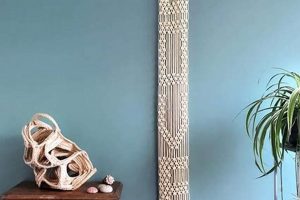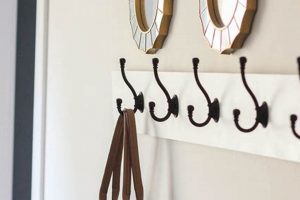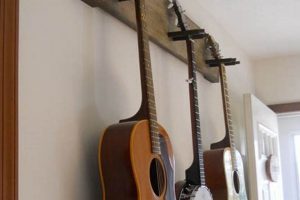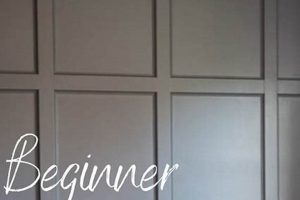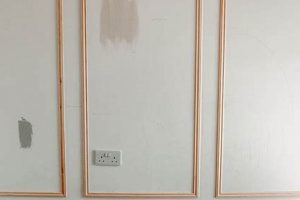Creation of verdant displays for interior spaces utilizing preserved mosses and applied by individuals represents a growing trend in home dcor. These botanical compositions offer a unique aesthetic and textural element to walls, providing a natural and visually appealing alternative to conventional artwork. For instance, individuals may construct a frame, adhere various types of moss to its surface, and arrange them into desired patterns, culminating in a personalized, living-inspired piece.
The appeal of constructing biophilic art pieces stems from several factors. Firstly, integrating natural elements into living environments is linked to improved well-being and a reduction in stress. Secondly, moss requires minimal maintenance, particularly when preserved, making it a sustainable and long-lasting dcor choice. Historically, the incorporation of plant life into architectural spaces has been a feature of diverse cultures, reflecting a deep connection between humans and the natural world. The current popularity echoes this historical precedent, adapted for modern sensibilities and practical constraints.
The subsequent sections will delve into specific materials and techniques employed in crafting these decorative pieces. Considerations will be given to moss selection, framing options, adhesive application, design principles, and methods for preserving the visual integrity of the finished product.
Tips for Crafting Botanical Wall Decor
Achieving successful results when creating moss-based wall art demands attention to detail and adherence to established best practices. The following recommendations offer guidance in material selection, construction techniques, and long-term preservation.
Tip 1: Moss Selection: Prioritize the use of preserved moss over living moss to eliminate the need for ongoing watering and maintenance. Different types of preserved moss (e.g., sheet moss, reindeer moss, sphagnum moss) offer varying textures and visual characteristics, allowing for nuanced design possibilities.
Tip 2: Substrate Preparation: The backing material, or substrate, should be rigid and moisture-resistant. Plywood, MDF, or sealed wooden boards are suitable options. Ensure the substrate is clean and free of debris before applying adhesive.
Tip 3: Adhesive Application: Employ a strong, non-toxic adhesive specifically designed for crafts. Hot glue or construction adhesive can provide a secure bond between the moss and the substrate. Apply adhesive sparingly to avoid saturation and maintain the natural texture of the moss.
Tip 4: Design Planning: Sketch or plan the intended design before adhering any moss. This allows for experimentation with different arrangements and ensures a balanced composition. Consider incorporating varying depths and textures to create visual interest.
Tip 5: Layering Techniques: When layering different types of moss, begin with a base layer of sheet moss to provide coverage and stability. Subsequently, add accents and focal points using other moss varieties.
Tip 6: Edge Finishing: Neatly trim any excess moss along the edges of the frame or substrate to create a clean and professional finish. This step enhances the overall aesthetic appeal of the completed artwork.
Tip 7: Color Preservation: To maintain the vibrancy of the preserved moss, avoid direct sunlight exposure. Prolonged exposure to UV rays can cause fading and discoloration.
Tip 8: Dust Removal: Periodically remove dust from the moss surface using a soft brush or compressed air. This helps preserve the appearance of the artwork and prevents the accumulation of debris.
Implementing these tips will contribute to a more successful and enduring outcome when constructing moss wall art. The careful selection of materials and meticulous execution of techniques ensures a refined and visually compelling piece.
The final section will offer guidance on integrating the completed piece into a specific interior environment.
1. Preserved Moss Selection
The selection of preserved moss directly influences the aesthetic qualities, longevity, and maintenance requirements of wall art. As the primary medium in these creations, the type and quality of moss dictate the textural range, color palette, and overall visual impact of the finished piece. For instance, using a combination of reindeer moss and sheet moss introduces varying levels of depth and texture, resulting in a more dynamic and visually engaging composition. The choice of preservation method also affects color retention; poorly preserved moss may fade or discolor over time, diminishing the artwork’s aesthetic value. Proper moss selection, therefore, is a foundational step in ensuring the success and visual appeal of the final botanical display.
The decision to use preserved, rather than living, moss addresses practical considerations related to long-term care and environmental control. Preserved moss requires no watering, fertilization, or specific lighting conditions, making it a low-maintenance alternative suitable for interior environments where maintaining living plants would be challenging. For example, incorporating preserved moss in a windowless office setting provides the visual benefits of greenery without the need for specialized horticultural care. The range of preserved moss types available including sheet, reindeer, cushion, and Spanish moss allows for diverse design options, from minimalist, monochromatic arrangements to complex, multi-textured compositions. The selection process should consider the desired aesthetic outcome, the environmental conditions of the intended display location, and the ease of maintenance for the end user.
In conclusion, preserved moss selection is a critical determinant of the success of botanical wall art. The selection of moss dictates aesthetic appeal, ease of maintenance, and environmental suitability. Understanding these connections is essential for achieving the desired visual and practical outcomes, aligning artistic intent with the realities of long-term preservation and display. Overlooking the importance of appropriate moss selection can lead to premature degradation, increased maintenance demands, and diminished aesthetic value, negating the intended benefits of the artwork.
2. Substrate Material Choice
The selection of an appropriate substrate is paramount to the structural integrity and longevity of botanical wall art. The substrate serves as the foundational support upon which moss is affixed; its properties directly influence the artwork’s resistance to warping, moisture damage, and overall stability. Inadequate substrate selection can compromise the piece, leading to premature degradation and necessitating costly repairs or replacements.
- Moisture Resistance
Substrates must exhibit resistance to moisture to prevent fungal growth and structural weakening. Materials like untreated wood, particularly softwoods, are susceptible to water absorption, which can lead to warping and detachment of the moss. Waterproofed plywood, PVC panels, or sealed MDF offer enhanced moisture resistance, mitigating these risks. An example is the use of marine-grade plywood in humid environments to ensure durability.
- Weight-Bearing Capacity
The substrate must possess adequate weight-bearing capacity to support the combined weight of the moss, adhesive, and any additional decorative elements. Thin or flimsy materials may bow or bend under the load, compromising the artwork’s aesthetic appeal and structural integrity. Solid wood panels or reinforced composite materials are suitable choices for larger pieces or those incorporating heavier moss varieties. Large-scale installations benefit from using a metal frame behind the substrate for added reinforcement.
- Adhesive Compatibility
The substrate material must be compatible with the chosen adhesive to ensure a strong and durable bond between the moss and the backing. Certain adhesives may not adhere effectively to smooth or non-porous surfaces, resulting in premature detachment of the moss. Roughening the substrate surface with sandpaper or using a primer can improve adhesive bonding. Experimentation with small samples is recommended to verify compatibility. For instance, acrylic adhesives are generally effective on a wider range of substrates compared to solvent-based adhesives.
- Dimensional Stability
Substrates should exhibit minimal expansion and contraction in response to temperature and humidity fluctuations to prevent warping and cracking. Materials with high coefficients of thermal expansion can cause stress on the adhesive bonds and the moss itself, leading to structural failure. Kiln-dried wood or composite materials with low thermal expansion rates are preferable for environments with variable climates. An example is the selection of MDF over solid wood in climates with significant humidity changes.
The facets of moisture resistance, weight-bearing capacity, adhesive compatibility, and dimensional stability collectively influence the long-term viability and aesthetic integrity of botanical wall art. Choosing an appropriate substrate requires careful consideration of the intended environment, the size and weight of the artwork, and the properties of the chosen moss and adhesive. Failure to adequately address these factors can result in structural instability, premature degradation, and ultimately, a diminished aesthetic experience.
3. Adhesive Bond Strength
Adhesive bond strength is a critical determinant of the longevity and aesthetic integrity of botanical wall art. It directly governs the secure attachment of moss to the substrate, influencing resistance to environmental stressors and preventing detachment, thereby preserving the intended design.
- Surface Preparation Influence
Surface preparation significantly affects bond strength. Contaminants like dust, oils, or loose particles on the substrate impede proper adhesion. Abrasive cleaning or the application of a primer enhances surface energy, promoting stronger intermolecular interactions between the adhesive and the substrate. For example, sanding a glossy surface increases its roughness, thereby providing a greater surface area for mechanical interlocking of the adhesive.
- Adhesive Type Selection
Different adhesive chemistries exhibit varying bond strengths depending on the materials being joined. Cyanoacrylates (super glues) offer rapid bonding but may lack flexibility and long-term durability. Construction adhesives provide a robust, water-resistant bond suitable for larger installations, though they typically require longer curing times. Hot melt adhesives are convenient for small-scale projects but may soften under elevated temperatures. The ideal choice balances bond strength with material compatibility, cure time, and environmental resistance. For example, using a polyurethane adhesive on a porous substrate, like wood, creates a strong, permanent bond.
- Application Technique Impact
The method of adhesive application directly affects bond strength. Inadequate adhesive coverage creates weak points prone to failure. Conversely, excessive adhesive can lead to squeeze-out, compromising aesthetics and potentially weakening the bond line. Uniform application, either through spraying, brushing, or dispensing, ensures consistent contact between the moss and the substrate. Applying a thin, even coat of adhesive maximizes surface area contact and minimizes the risk of trapped air bubbles.
- Environmental Stress Resistance
Adhesive bonds are subjected to various environmental stresses, including temperature fluctuations, humidity, and UV exposure. These factors can accelerate degradation and reduce bond strength over time. Selecting adhesives with resistance to these specific stressors is crucial for ensuring long-term performance. For instance, using a UV-resistant adhesive in a sunlit environment mitigates yellowing and embrittlement, thereby preserving the bond’s integrity. Additionally, selecting a water-resistant adhesive prevents the bond from weakening in humid or damp conditions.
Adhesive bond strength constitutes a critical aspect of botanical wall art construction, affecting structural integrity, longevity, and resistance to environmental stressors. Proper surface preparation, adhesive type selection, application technique, and environmental stress resistance are all determinants in maintaining robust adhesion. Failure to address these elements directly compromises the final product’s durability and visual appeal, thus emphasizing the importance of comprehensive understanding and adherence to best practices.
4. Design Composition Principles
The application of design composition principles significantly impacts the aesthetic outcome of botanical wall art. These principles, encompassing balance, contrast, rhythm, proportion, and unity, guide the arrangement of moss and other elements to create visually harmonious and engaging pieces. A failure to observe these principles can result in arrangements that appear chaotic, unbalanced, or lacking visual interest, diminishing the overall impact of the artwork. For example, an asymmetrical design employing the principle of balance may use a larger mass of darker moss on one side, counterweighted by a smaller, brighter element on the other, achieving equilibrium through contrast rather than exact mirroring.
Considerations of color theory, spatial relationships, and textural variation play a crucial role within design composition. Juxtaposing different moss types can create textural contrast, while a carefully curated color palette can evoke specific moods or complement the surrounding environment. The negative space surrounding the moss elements influences the overall visual flow and prevents the composition from appearing cluttered. For instance, a design emphasizing the principle of rhythm might employ a repeating pattern of moss types or colors, guiding the viewer’s eye across the artwork. Moreover, the scale and proportion of the art relative to its intended display area are important, too large can overwhelm the space, too small can be ignored. Such considerations ensure the artwork integrates harmoniously with the interior.
In summary, design composition principles are not merely aesthetic considerations; they are fundamental tools that contribute to the visual efficacy of moss wall art. Their thoughtful application ensures the artwork is not only visually appealing but also communicates a deliberate artistic intention. The careful integration of these principles transforms a collection of moss elements into a cohesive, impactful piece of art, underscoring the importance of understanding and applying design theory in the creation process.
5. Application Skill Level
Proficiency in various techniques directly influences the quality and aesthetic outcome of individually crafted moss-based wall art. Skill level impacts material handling, design execution, and the longevity of the finished piece.
- Material Manipulation
The capacity to effectively handle and manipulate different moss types distinguishes novice from experienced practitioners. Skilled artisans can seamlessly blend varying textures and colors, creating nuanced and visually appealing compositions. Conversely, inexperienced individuals may struggle with moss placement, resulting in a disjointed or uneven appearance. Proficiency includes knowing how to trim, shape, and adhere moss without compromising its natural texture or color.
- Adhesive Application Precision
Accurate adhesive application is critical for ensuring a secure and aesthetically pleasing bond between the moss and the substrate. Experienced individuals apply adhesive strategically, avoiding excess that can seep onto the moss surface or insufficient amounts that lead to detachment. Novices often apply adhesive haphazardly, resulting in visible glue lines or insecure moss placement. Mastering adhesive techniques requires practice and an understanding of adhesive properties and drying times.
- Design Interpretation and Execution
The ability to translate a conceptual design into a tangible piece of art relies heavily on technical skill. Experienced individuals can accurately interpret design sketches and adapt them to the physical constraints of the materials. They possess the expertise to create complex patterns, gradients, and three-dimensional effects using moss. In contrast, less skilled individuals may struggle to replicate intricate designs or may produce compositions that deviate significantly from the original concept. This involves understanding principles of balance, proportion, and color theory.
- Problem-Solving and Adaptation
Crafting moss-based wall art often presents unexpected challenges, such as uneven surfaces, material limitations, or design modifications. Experienced individuals possess the resourcefulness to overcome these obstacles through creative problem-solving and adaptation techniques. They can seamlessly integrate alternative materials, adjust designs to accommodate unforeseen issues, and maintain a consistent aesthetic throughout the process. Novices may become frustrated by these challenges and may be unable to find effective solutions, resulting in compromised results.
The level of skill applied during the construction process is a significant factor in the success and enduring quality of botanical wall art. Technical proficiency in material handling, adhesive application, design interpretation, and problem-solving directly influences the aesthetic appeal, structural integrity, and long-term viability of the finished piece. A commitment to skill development and continuous learning can elevate the craftsmanship and artistic merit of these creations.
6. Environmental Considerations
The creation of botanical wall art intersects directly with environmental consciousness. The source of materials, methods of preservation, and ultimate disposal of these art pieces all carry environmental implications. The selection of sustainably harvested or salvaged moss reduces the demand for ecologically damaging practices, such as clear-cutting or habitat destruction. Similarly, the use of non-toxic adhesives and backing materials minimizes the release of volatile organic compounds (VOCs) into indoor environments. Conversely, sourcing moss from unsustainable providers contributes to ecological degradation and habitat loss. The environmental ramifications of material choices are therefore a central consideration in responsible art creation. A shift towards natural and reusable materials minimizes the carbon footprint associated with production, transportation, and disposal.
Furthermore, the long-term maintenance of moss-based wall art also presents environmental considerations. The preservation process itself can involve chemicals that, if improperly handled or disposed of, can negatively impact ecosystems. Opting for preservation methods that employ natural or biodegradable substances mitigates this risk. Moreover, designing art pieces for disassembly and material reuse reduces waste and promotes circularity. For example, constructing a frame from reclaimed wood and using a reversible adhesive allows for the separation and repurposing of components at the end of the artwork’s lifespan. The end-of-life management of these art installations has profound environmental impacts, influencing waste accumulation and resource depletion.
In summary, the integration of environmental considerations into botanical wall art projects extends beyond mere aesthetic choices. It encompasses ethical sourcing, sustainable practices, and responsible disposal methods. A holistic approach that prioritizes environmental impact minimizes harm, promotes resource conservation, and aligns artistic expression with ecological responsibility. Addressing these environmental dimensions is not merely a matter of compliance but a commitment to sustainable art practices that benefit both human well-being and ecosystem health.
7. Longevity and Maintenance
The inherent connection between durability and upkeep significantly impacts the value and aesthetic appeal of botanical wall art. The longevity of these creations is not solely determined by initial construction but is equally dependent on ongoing maintenance practices. Neglecting appropriate maintenance directly results in aesthetic degradation, reduced lifespan, and ultimately, the need for costly repairs or replacements. Preserved moss, while requiring minimal care compared to living plants, necessitates specific attention to environmental conditions and routine cleaning. For instance, prolonged exposure to direct sunlight causes fading and brittleness in preserved moss, reducing its visual appeal and structural integrity. Conversely, consistent and appropriate care preserves the artwork’s original aesthetic qualities and extends its lifespan, maximizing the initial investment.
Effective maintenance strategies center on controlling environmental factors and implementing regular cleaning protocols. Avoiding direct sunlight and extreme humidity fluctuations are crucial preventative measures. Dust accumulation, a common issue in indoor environments, diminishes the moss’s vibrancy and can attract pests. Gentle dusting with a soft brush or the use of compressed air effectively removes surface debris without damaging the delicate moss fibers. Additionally, periodic inspection for signs of adhesive failure or pest infestation allows for early intervention, preventing more significant damage. For example, detecting a small area of detached moss allows for immediate re-adhesion, preventing further separation and maintaining the artwork’s integrity. The implementation of these proactive measures minimizes the need for extensive repairs and extends the lifespan of the art piece.
In conclusion, the correlation between durability and upkeep is fundamental to the sustained value of botanical wall art. Proactive maintenance, encompassing environmental control and routine cleaning, serves as a critical investment in preserving the artwork’s aesthetic appeal and extending its lifespan. Understanding the cause-and-effect relationship between maintenance practices and longevity empowers owners to safeguard their investment, ensuring that the botanical display continues to enhance the interior environment for years to come. Failure to acknowledge this connection results in premature degradation, diminished visual impact, and ultimately, a shortened lifespan for the botanical creation.
Frequently Asked Questions
The following addresses commonly raised inquiries pertaining to the creation and maintenance of verdant wall displays:
Question 1: What is the anticipated lifespan of a moss-based wall display?
The lifespan hinges primarily on the quality of materials and adherence to appropriate maintenance procedures. Expect a lifespan ranging from five to ten years with diligent care. Factors include moss quality, adhesive type, and environmental control.
Question 2: Are special lighting requirements necessary for preserved moss wall decor?
Preserved moss necessitates no specific lighting conditions. However, direct sunlight exposure promotes color fading and desiccation. Diffused or indirect light is optimal for preserving the vibrancy and texture of the material.
Question 3: Is regular irrigation required for preserved moss installations?
Preserved moss undergoes a stabilization process, negating the requirement for watering. Introducing moisture may induce mold growth or material degradation. Maintaining a dry environment is essential for longevity.
Question 4: What methods are optimal for dust removal from wall-mounted greenery?
Gentle dusting with a soft-bristled brush or compressed air effectively removes accumulated dust. Avoid abrasive cleaners or excessive force, which compromises the moss structure.
Question 5: What adhesive types are suitable for adhering moss to a substrate?
Non-toxic, low-VOC adhesives, such as construction adhesives or hot glue, are appropriate. Ensure adhesive compatibility with both the moss and substrate to ensure a durable bond.
Question 6: Can diverse moss varieties integrate into a single wall display?
Combining multiple moss types is feasible, providing aesthetic variation and textural contrast. Select mosses with compatible moisture requirements and preservation techniques for optimal integration.
Proper material selection and meticulous maintenance practices contribute to the longevity and aesthetic preservation of botanically-inspired wall art. Adherence to these recommendations mitigates the risk of premature degradation and maximizes the visual impact of the piece.
The concluding section provides guidance on integrating these decorative elements within a range of architectural settings.
Conclusion
The preceding discourse has elucidated critical elements inherent to the creation and preservation of diy moss wall art. Attention to substrate selection, adhesive properties, design principles, and environmental factors directly influences the aesthetic appeal and longevity of these botanical installations. Mastery of these aspects is vital for achieving visually compelling and enduring results. diy moss wall art presents a unique opportunity to integrate biophilic design into interior spaces, but requires informed and deliberate execution.
The enduring appeal of diy moss wall art lies in its ability to transform static environments into dynamic, visually stimulating areas. Continued research into sustainable materials, refined construction techniques, and effective preservation methods will further enhance the possibilities within this art form. It is crucial that practitioners prioritize both artistic expression and environmental responsibility to maximize the lasting impact of these distinctive creations.



